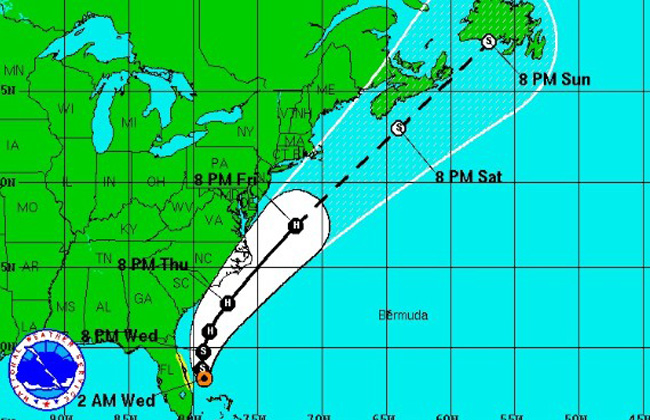
Last Updated: 9:30 a.m. Wednesday
Wednesday Update– You won;t have to worry much about Tropical Storm Arthur, even as it churns toward self-birthing Hurricane Arthur.
Wednesday morning Arthur was 200 miles southeast of Jacksonville, but the storm, according to the National Weather Service in Jacksonville, was on a path to remain far out at sea, tracking northeast and away from Florida, as well as other lands further north. The storm is expected to develop into a hurricane “over the next couple of days,” the weather service says.
That doesn’t mean swimmers and boaters should throw caution to what light winds will still breeze through the area: Flagler shores’ surf will see the impact of the storm, and rip currents will be very dangerous as Independence Day vacationers swarm the beaches.
“A tropical storm warning remains in effect for the Atlantic coastal waters 20-60 NM offshore,” the weather service warns. “We are expecting tropical storm conditions over the waters later today through tonight. A high risk of rip currents was issued for local beaches today. Squalls of showers and isolated thunderstorms will rotate onshore working their way northward through tonight. Gusty winds and brief locally heavy rainfall will be possible in these squalls. Rainfall amounts may near 1-2 inches along the immediate coast, especially south of St. Augustine through Thursday.”
Remarkably, the National Hurricane Center’s website was not accessible Wednesday morning.
![]()
Earlier Reports:
NOAA sent this afternoon update Tuesday, July 1: “At 2:00 p.m. EDT, Tropical Storm (TS) Arthur was located near latitude 27.9 north and longitude 79.4 west, or approximately 210 miles south-southeast of Mayport, Florida. This position is also about 150 miles southeast of Flagler Beach, Florida. TS Arthur is moving northwest at 5 mph. This general motion should continue through tonight, followed by a turn toward the north on Wednesday. The center of the tropical cyclone is expected to remain offshore and move east of the central Florida east coast during the next day or so. The system is forecast to pass 80 to 120 miles offshore of northeastern Florida on Wednesday and Wednesday night and about 120 to 140 miles east of southeast Georgia coast early Thursday morning. Tropical storm force winds extend outward up to 45 miles from the center. Conditions should allow for at least steady strengthening and TS Arthur is expected to become a hurricane offshore or near the Carolina Coasts by Thursday night and Friday morning.”
Earlier:
The first tropical storm of the season is organizing 170 miles southeast of Flagler Beach and is heading up the Florida coast, strengthening as it parallels it, with storms, wind and rain in Flagler County’s forecast starting late Tuesday night and through Wednesday.
Palm Coast’s Independence Day festivities the evening of July 3 may be affected, but probably not by much, with the chance of thundershowers diminishing considerably as the day wears on and almost disappearing by 9 p.m., when the fireworks are to be set off. There is a 40 percent chance of rain on July 4, which would affect Flagler Beach’s parade at mid-day, and its fireworks at 9:30 p.m. The parade is setting off rain or shine.
A storm surge is expected on Wednesday and Thursday along the coast, making for spectacular shore-watching. Waves are expected to reach 5 to 6 feet tonight and 7 to 9 feet Wednesday.
At 8 a.m. Tuesday, the storm was stationary, with winds of 35 miles per hour. “Conditions are favorable for this depression to develop into a Tropical Storm later today and then track north and northeast offshore the northeast Florida and southeast Georgia coast Wednesday night,” the National Weather Service in jacksonville said this morning. “Forecast models have come into good agreement with this storm strengthening to Tropical Storm strength as it moves northward while paralleling the southeast Atlantic coast through late Thursday.”
Scattered showers and thunderstorms are expected to begin to move onshore later today, edging their way northward up the Atlantic coast tonight through late Wednesday. Bands of showers and isolated thunderstorms will move onshore through Wednesday night, with locally heavy rainfall possible. Rainfall amounts of 1 to 2 inches are possible generally south of St Augustine through Thursday, with locally higher amounts. Gusty winds in squalls may reach up to 40 mph. Inland, rains should be lighter.
Mariners, swimmers and surfers beware. Northeast winds are expected to increase to tropical storm strength Wednesday and Wednesday night 20 to 60 miles offshore. Winds will increase up to 35 knots offshore with gusts up to 50 knots possible Wednesday through Wednesday night. Mariners are encouraged to continue to closely monitor this system. As onshore winds increase through midweek and swells build, the chance of dangerous rip currents along the coast will also increase. Today (Tuesday) here is a moderate risk of rip currents, with a high risk of rip currents expected on Wednesday. Breezy east-northeast winds will near 15-20 mph today and Wednesday with higher gusts.
As the storm moves north, the Georgia, South Carolina and North Carolina coasts are expected to feel the impact with bands of rain and gusts of wind. More significantly, the deteriorated weather will affect weekend travel along the I-95 corridor. Still, with the track of the storm less than certain, the forecasts are weaker the further they are from the day they’re made.






























Leave a Reply